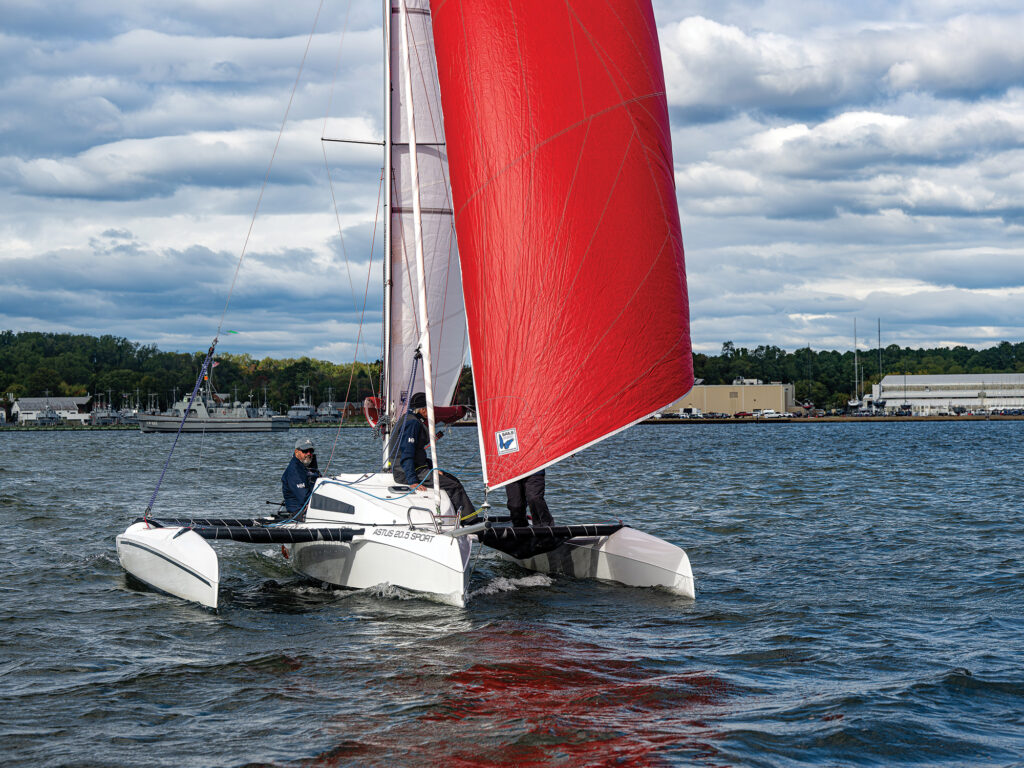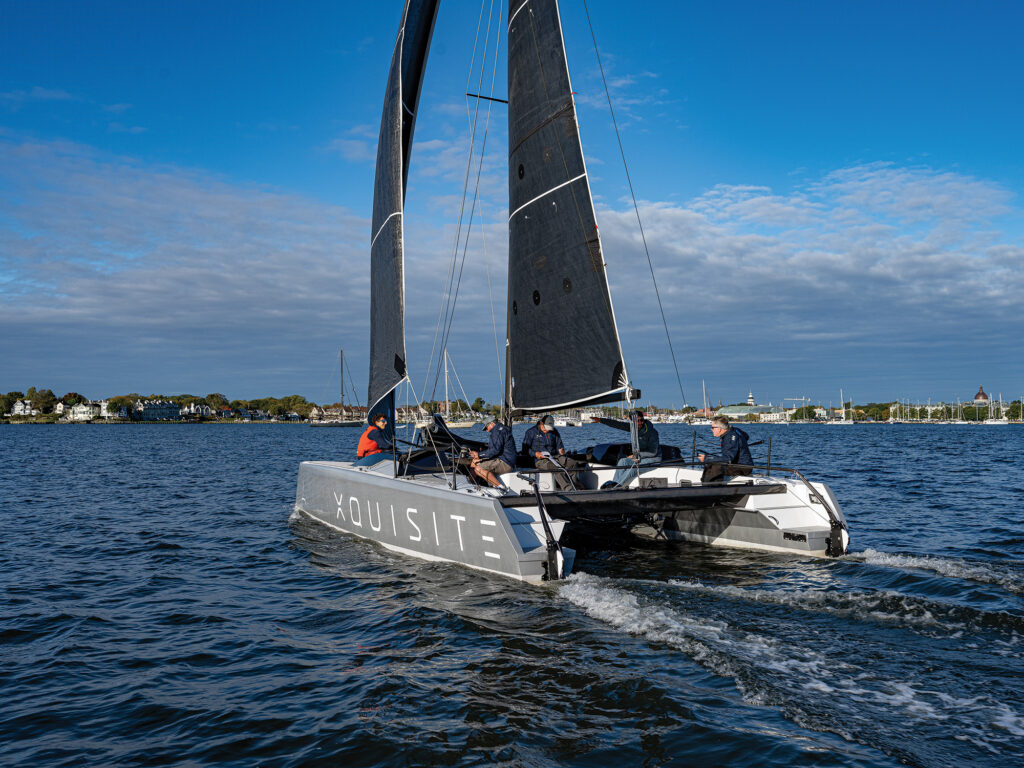
Astus 20.5
The lineup of feature-packed new sailboats at this past fall’s Annapolis Sailboat Show included a couple of sporty multihulls that stood out from the crowd, mostly because of what they went without. Rather than boasting plush accommodations and elaborate systems, the Astus 20.5 Sport trimaran and the Xquisite 30 Sportcat didn’t have so much as a padded cockpit cushion between them. No flat-screen TV. No air conditioning. No suite of navigation instruments. No fridge or freezer. No en suite head and shower. Zip. Nada. Nuttin’.
What they did have, however, was the promise of fun sailing. And with a sleeping bag, a camp stove and a cooler, either boat would be a fine weekender on which to fly across bays or explore skinny water.
The 19-foot-6-inch Astus is built in France and designed by VPLP, the same naval architects who design Lagoon and Excess catamarans, and racing machines such as Banque Populaire XI, Comanche and Groupama 3. With a price tag of $29,500, the Astus was by far the least-expensive sailboat that Cruising World Boat of the Year judges inspected. The builder, Astus Boats, has proa and trimaran models that range from 14 to 26 feet.
The 20.5’s center hull and amas are vacuum-infused, and the main hull flares out above the waterline to cut down on spray. The floats to either side are attached with tubes that can be retracted or extended and pinned in place. Collapsed, the boat has a beam of 8 feet, 2 inches, making it easily trailerable. Extended, the tri is just under 15 feet wide and quite stable, even with four of us aboard for a test sail on Chesapeake Bay.
To be honest, the boat was overloaded, but still, it danced right along in an 8- to 10-knot breeze. Tacking upwind with the main and working jib, our GPS speed was 5.2 knots. With the screecher rolled out on its continuous-line furler set on the boat’s aluminum bowsprit, we saw speeds in the high-7-knot range with occasional bursts of 8 or so.
The local Astus dealer from Red Beard Sailing said that the boat, with its mast stepped on a tabernacle on deck, is fairly simple to rig and get into the water from its trailer. With its centerboard up, the boat draws just 10 inches; down, the draft is about 4 feet. For getting to and from the launch ramp or dock, the Astus can handle up to a 6 hp outboard.
The cabin in the center hull has sitting headroom and enough space to escape the weather, or for a couple of people to sleep. There’s space for a portable toilet under a V-berth. Other than that, accommodations are minimal—and that’s point. The Astus is intended to be a speedy little machine to enjoy on your favorite body of water and then be taken home and stored in the yard.
Astus 20.5 Sport Specifications
| LENGTH OVERALL | 19’6″ (5.95 m) |
| WATERLINE LENGTH | 19’6″ (5.95 m) |
| BEAM | 14’9″ (4.5 m) |
| DRAFT | 10″/4′ (0.25/1.25 m) |
| DISPLACEMENT | 1,036 lb. (470 kg) |
| DESIGNER | VPLP |
| PRICE | $29,500 |
| Astus Boats |

Xquisite 30 Sportcat
The Xquisite 30 Sportcat has just about equally spartan creature comforts, though in two slightly more spacious hulls, thanks to a length overall of 30 feet, 4 inches. At first glance, the boat is somewhat reminiscent of the old Stiletto Catamarans, thanks to cowl-like hatches amidships in either hull that open to enough room below for a mattress, a place to stow gear, and a basic electrical system with LED lighting.
The Sportcat is designed by French naval architect Francois Perus, co-founder of The Yacht Design Collective. The idea, he said, was to build a fast family cruiser.
As with Xquisite’s larger bluewater cruising cats, the Sportcat is not a vessel built to a price point. Its hulls are foam-cored and infused using vinylester resin, with carbon-fiber reinforcements in high-load areas. Crossbeams are also made with carbon fiber, as are the rotating mast, rudders and bowsprit. The boat we sailed in Annapolis came with mini keels; carbon-fiber and epoxy daggerboards are an option.
Mesh trampolines are used in the cockpit and foredeck to reduce weight, and the composite deck amidships is covered with Flexiteek synthetic decking for traction. Sails on the boat in Annapolis were made by North and included a square-top 3Di Endurance main, jib, and G-Zero gennaker. The boat we sailed was powered by a 6 hp Mercury outboard; an electric motor is an option. Hull No. 1 carried a price tag of $258,000, but according to the Xquisite website, the current price is $285,000.
Xquisite Yachts, whose primary business is building luxury cruising catamarans, chose the sport design primarily as a training platform for its big-boat customers who visit the company’s facility in the Bahamas. Some of its owners are relatively new to the sport, and the Sportcat is intended for them to get an idea of how a multihull feels under sail. But it also is quite capable of pleasing sailors with a desire to go out and rip it up, which is just what the Boat of the Year team did one early morning on Chesapeake Bay. At the outset, the breeze was light, in the 5- to 8-knot range, and we saw speeds of 6 and 7 knots sailing upwind with the working jib. With the gennaker rolled out, we were matching windspeed, no problem.
The boat’s twin rudders are tied together by a carbon pipe, and the boat is steered using a long tiller extension, which lets the helmsman sit outboard on the windward hull, where there’s good visibility of main and headsail telltales. Tacking involves a bouncy dash across the aft trampoline—a fun maneuver once you get the hang of it.
After an hour or more on the water, given the Sportcat’s sparkling performance and the quality of its build and equipment, we judges had no other option but to name it Best Sportboat of 2024.
Xquisite 30 Sportcat Specifications
| LENGTH OVERALL | 30’4″ (9.24 m) |
| WATERLINE LENGTH | 29’4″ (8.95 m) |
| BEAM | 13’5″ (4.1 m) |
| DRAFT | 2’6″ (2.46 m) |
| DISPLACEMENT | 3,196 lb. (1,450 kg) |
| DESIGNER | Francois Perus |
| PRICE | $285,000 |
| Xquisite Yachts |
Mark Pillsbury is a CW editor at large and was a 2024 Boat of the Year judge.








